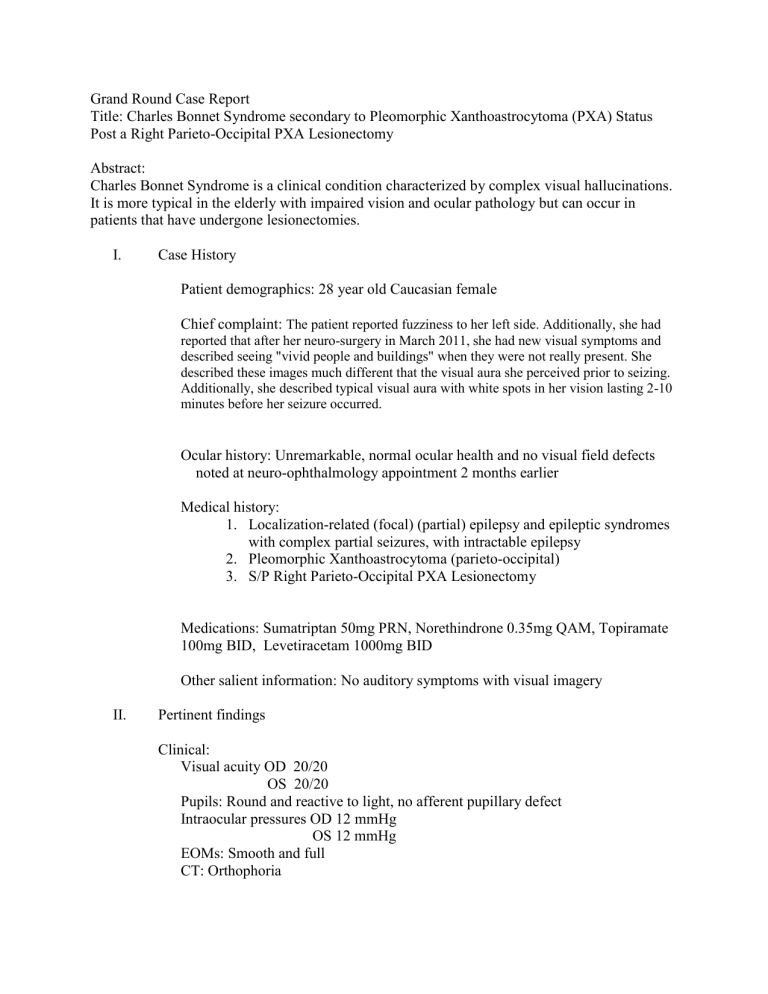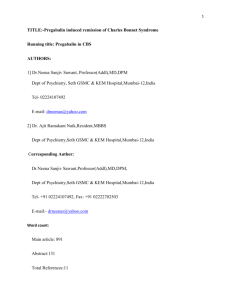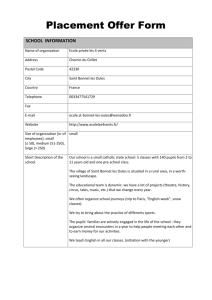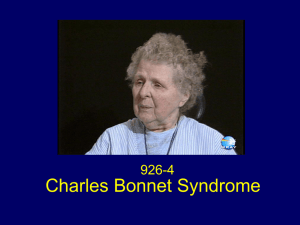outline31313

Grand Round Case Report
Title: Charles Bonnet Syndrome secondary to Pleomorphic Xanthoastrocytoma (PXA) Status
Post a Right Parieto-Occipital PXA Lesionectomy
Abstract:
Charles Bonnet Syndrome is a clinical condition characterized by complex visual hallucinations.
It is more typical in the elderly with impaired vision and ocular pathology but can occur in patients that have undergone lesionectomies.
I.
Case History
Patient demographics: 28 year old Caucasian female
Chief complaint: The patient reported fuzziness to her left side. Additionally, she had reported that after her neuro-surgery in March 2011, she had new visual symptoms and described seeing "vivid people and buildings" when they were not really present. She described these images much different that the visual aura she perceived prior to seizing.
Additionally, she described typical visual aura with white spots in her vision lasting 2-10 minutes before her seizure occurred.
Ocular history: Unremarkable, normal ocular health and no visual field defects
noted at neuro-ophthalmology appointment 2 months earlier
Medical history:
1.
Localization-related (focal) (partial) epilepsy and epileptic syndromes with complex partial seizures, with intractable epilepsy
2.
Pleomorphic Xanthoastrocytoma (parieto-occipital)
3.
S/P Right Parieto-Occipital PXA Lesionectomy
Medications: Sumatriptan 50mg PRN, Norethindrone 0.35mg QAM, Topiramate
100mg BID, Levetiracetam 1000mg BID
Other salient information: No auditory symptoms with visual imagery
II.
Pertinent findings
Clinical:
Visual acuity OD 20/20
OS 20/20
Pupils: Round and reactive to light, no afferent pupillary defect
Intraocular pressures OD 12 mmHg
OS 12 mmHg
EOMs: Smooth and full
CT: Orthophoria
Slit Lamp Examination
Lids/lashes: clear OU
Conjunctiva: clear OU
Cornea:
OD: clear
OS: clear
Anterior chamber: clear OU
Iris: clear OU
Lens: clear OU
Dilated fundus examination:
C/D ratio: (no edema or pallor OU)
OD: 0.2
OS: 0.2
Macula: clear OU
Vitreous: clear OU
Vessels: clear OU
Peripheral retina: clear OU, no intraocular metastasis noted
Humphrey visual field 24-2: inferior left quadrantopsia
Radiologic findings (No pre-operative MRI readings available)
There is a small right temporoparietal craniotomy defect with an underlying parenchymal defect involving gray and white matter of the lateral right occipital lobe. Overall impressions include postoperative changes in the lateral right occipital lobe
Differential diagnosis
Primary: Inferior left quandrantopsia, Charles Bonnet Syndrome
DDx: Visual aura with Epilepsy
III.
Discussion
PXA is a rare type of astrocytic tumor that accounts for less than 1% of all primary brain tumors (1) (2). The majority of cases occur in patients less than 30 years of age (3). The suptratentorial region of the brain is the location of 98% of these tumors, however they have been reported in the cerebellum, spinal cord, and retina as well (1) (4). Of the supratentorial region in the brain, the temporal lobe is more frequently affected (39%), followed by the frontal lobe (19%), parietal lobe
(14%), occipital lobe (9%) (2) (5). The most common presenting symptom of this tumor is seizure which occurs in over 70% of patients, however, other symptoms
include headache, nausea, dizziness, and visual disturbance (1) (6). The most common treatment is maximum, careful surgical resection, called a lesionectomy, as was performed on the patient in this case study (2) (7).
While a lesionectomy is able to most often accomplish the goal of reduction or the complete cessation of seizures and also decreasing the risk possible future malignant conversion of the tumor in most patients; there are risks. These risks include visual field defects, cognitive defects, stroke (1-2%), and death (0.1%)
(8). The risk of visual field defect is low at approximately 8-10 percent (9).
Charles Bonnet Syndrome is complex visual hallucination that is most often reported in elderly patients with blindness or severe visual impairment suffering from degenerative eye conditions. There have been a handful of cases described where visual images occur in a younger patient that has experienced a visual field defect as a consequence of their lesionectomy that involve the optic tract (10).
Charles Bonnet Syndrome has essential features that must be present for diagnosis including elaborate, vivid images, insight that these images are not real, and absence of psychiatric disorders (11) . All of these criteria were met by the patient in the case study. There have also been arguments that visual hallucinations in these post surgical epilepsy patients are epileptogenic in nature, however, the description of this visual phenomena differs (12). In contrast, visual perceptions with a seizure are described as brief, disconnected, simple (such as flashing lights, stars, a blinking sqaure), and associated with other symptoms such as vocalizations, vegetative or motor phenomena, and loss of consciousness (13).
The patient in this case study had experienced visual aura (a simple flashing white light) prior to her seizures, but described her current visual hallucinations as much more vivid and colorful.
.
IV.
Treatment and Management
As in the treatment of Charles Bonnet Syndrome in patients who are more elderly with advanced eye conditions; therapeutic options are limited.
Reassurance to the patient that these visual hallucinations have been reported in those that have undergone surgical brain resection and with visual field defects and that it is not a sign of mental illness is critical. The use of antipsychotic drugs remains debatable. Most cases of Charles Bonnet Syndrome will resolve spontaneously without intervention (12).
V.
Conclusions
This case shows the importance that eye care practitioners understand that
Charles Bonnet Syndrome can occur in a patient population other than the elderly and those with advanced eye condition. In this case, the patient’s visual acuity was normal; however because of her visual field defect and lesionectomy, she experienced visual hallucinations consistent with Charles Bonnet. The patient was relieved about her diagnosis and that her visual hallucinations were not a sign of
impending mental illness. She remains seizure free and is able to function well despite her visual field defect.
Bibliography
1. Pleomorphic Xanthoastrocytoma in Children and Adolescents. Amulya A. Nageswara Rao,
Nadia N. Laack, Caterina Giannini, Cynthia Wetmore.
2010, Vol. 55, pp. 290-294.
2. Patterns of care and outcomes of patients with pleomorphic xanthoastrocytoma: a SEER
analysis. Stephanie M. Perkins, Nandita Mitra, Wan Fei, Eric T. Shinohara. 20012, J
Neurooncol , Vol. 110, pp. 99-104.
3. Pleomorphic Xanthoastrocytoma: An Atypical Astrocytoma. Mubashira Hashmi, Shaista
Anwar Siddiqi, Liaqaut Ali, Syed Ahmed Asif.
2, February 2012, Journal of the Pakistani
Medical Association, Vol. 62, pp. 175-177.
4. Pleomorphic Xanthoastrocytoma of the Retina. Zarate Jorge, Sampaolesi, Roberto. [ed.] 79-
81. 1, January 1999, Vol. 23.
5. Pleomorphic Xanthoastrocytoma: Case Report and Analysis of the Literature Concerning the
Efficacy of Resection and the Significance of Necrosis. Pahapill, Peter A. M.D., Ph.D.,
Ramsay, David A. M.D., D.Phil. and Del Maestro, Rolando F. M.D., Ph.D.
4, April 1996,
Neurosurgery, Vol. 38, pp. 822-829.
6. Mintzer, Scott and Dropcho, Edward.
Clinical Summary: Pleomorphic Xanothocytoma.
Neurology Medlink. [Online] July 14, 2012. [Cited: January 27, 2013.] http://www.medlink.com/medlinkcontent.asp.
7. Pleomorphic xanthoastrocytoma: Favorable outcome after complete surgical resection.
Maryam Fouladi, Jesse Jenkins, Peter Burger, James Langston, Thomas Merchant,.
July
2001, Neuro Oncology, Vol. 3, pp. 184-192.
8. Robert S. Fisher, M.D., Ph.D.
Stanford Epilepsy Center. Risk and Benefits of Surgery.
[Online] 2013. [Cited: January 27, 2013.] http://neurology.stanford.edu/divisions/e_27.html.
9. Morbidity profile following aggressive resection of parietal lobe gliomas. Nader Sanai, M.D.,
Juan Martino, M.D., and Mitchel S. Berger, M.D.
Journal of Neurosurgery, Vol. 116, pp.
1182-1186.
10. Complex visual hallucinations (Charles Bonnet syndrome) in visual field defects following
cerebral surgery. THOMAS M. FREIMAN, M.D., RAINER SURGES, M.D., VASSILIOS I.
VOUGIOUKAS, M.D., ULRICH HUBBE, M.D., JOCHEN TALAZKO, M.D., JOSEF
ZENTNER, M.D.,JÜRGEN HONEGGER, M.D., AND ANDREAS SCHULZE-
BONHAGE, M.D.
2004, Journal of Neurosurgery, Vol. 101, pp. 846–853.
11. Complex Visual Hallucinations After Occipital Cortical Resection in a Patient with Epilepsy
Due to Cortical Dysplasia. Choi Eun Jung, Jung-Kyo Lee, Joong-Koo Kang, Sang-Ahm Lee.
2005, Archives of Neurology, Vol. 62, pp. 481-484.
12. Complex visual hallucination (Charles Bonnet Syndrome) in Visual Field Defects Following
Cerebral Surgery. Freiman Thomas, Rainer Surges, Vassilios Vougioukas, Ulrich Hubbe,
Jochen Talazko, Josef Zenter, Jurgen Honegger, Andreas Schulze-Bonhage.
Novmeber
2004, Journal of Neurosurgery , Vol. 101, pp. 846-853.
13. Localizing value of epileptic visual auras. Bien CG, Benninger FO, Urbach H, Schramm
J, Kurthen M, Elger CE.
s.l. : 123, 2000, Brain, Vol. 2, pp. 244-53.
14. Simon Shorvon, Emilio Perucca, Engel Jerome.
The Treatment of Epilepsy. s.l. : Wiley-
Blackwell, 2009. 1405183837.







